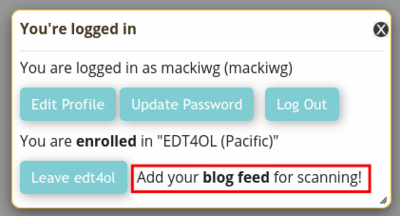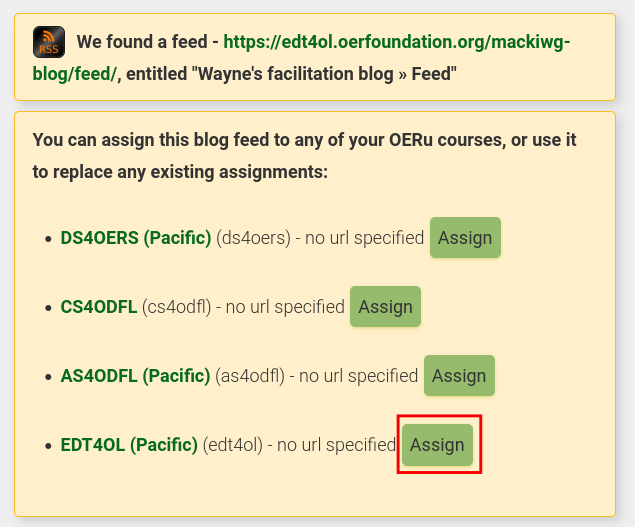EDT4OL/Portfolio/Outputs portfolio blog
Contents
Tasks for this challenge
Prepare a blog post, for example by editing the default "Hello world!" template post on your new blog site or creating a new post. From your Dashboard, go to "Posts". Click "Add New" or edit the existing "Hello world" template post.
- Choose an appropriate title for your post, for example: "My Acceptance Portfolio Submission", "Declaring myself on EDT4OL", or any other suitable title
- Your post must include an openly licensed "Featured image", which you can legally copy and upload via the "Post" tab option in WordPress when editing an individual post
- Purpose: To demonstrate legally correct image attribution adhering to the TASL requirements, providing an image Title, Author, Source (with hyperlink to the original source), and Licence
- A good way to do this in the context of a blog post is to provide an "Image attribution" subheading at the bottom of the post, with the attribution
- Attribution text example: Laptop on green grass by Tofros.com dedicated to the public domain under CCO
- Your blog post must be divided into three sub-sections using subheadings:
- Declaring myself: In a couple of sentences, tell us who you are, why you are taking the course, and what you hope to achieve.
- My acceptance portfolio evidence: Please provide evidence for the required components of your portfolio, specifically:
- A hyperlink to your WikiEducator Userpage to provide evidence of your basic wiki editing skills;
- Upload and link to a copy of your Certificate of Completion for the DS4OERS course and publish the validation code that appears on your certificate. OR alternatively, you must provide links to at least two DS4OER badges awarded to you.
- Log into the Moodle site where you earned your DS4OER Badges.
- Then go to your badges page from your user profile. So, for example, if you were awarded the DS4OER badges from the OERu Moodle site, the link would be: https://moodle.oeru.org/badges/mybadges.php. If you took the course on another Moodle site replace "https://moodle.oeru.org" with the URL of the specific Moodle site and add
/badges/mybadges.phpas the suffix to the URL after you have logged in. - Check that your badges are publicly visible so that the "Eye" icon doesn't have a line through it.
- Click on the Badge you would like to submit to reveal the metadata page that shows details about the Recipient, Issuer, and Badge. Copy and save the URL of the badge metadata page. It should have
?hash=contained within the URL, for example: https://moodle.oeru.org/badges/badge.php?hash=e94114af513803cebf6884a2860fca1103bd0677. This is the link you must use in your blog post to link to your badge providing evidence that the badge was awarded, including details of the issuer. If you don't link to this metadata page for your badge, your portfolio cannot be accepted.
- Upload a copy of your signed learning contract to your blog site and hyperlink to this file. You can upload a PDF version or an image file (JPG or PNG) if you took a photo of your contract for submission. (To upload the learning contract on your blog site, from your Dashboard go to the Media link, click on the "Add New" button, and follow the instructions on screen. From the media link, you should see your file listed. Click on the media file to reveal the URL for the file location which you will need for the hyperlink in your blog post. You can copy the URL to your clipboard before creating the hyperlink in your post.)
- My learning reflection: Write a brief reflection on this blog challenge activity in a sentence or two. For example: What did you learn? Based on your experience, what advice would you give to future learners completing this challenge?
- Categorise and tag your blog post: This will set up your blog to find related posts in designated categories and enable automated links to your blog posts to be inserted into the Course feed page.
- Think about a category structure for your blog, eg "Portfolio", "Learning Challenge", "Personal" to distinguish types of posts on your site. Create and assign a new category to your blog post.
- Tag your post with the course code: "EDT4OL". In the first instance, you will need to use the "Add New Tag" option.
Register your blog URL for the feed scanner
This will register your blog for the feed scanner which is done from the course website. The automated process will find the RSS or ATOM feed of your blog site, which is a machine readable format for automating links to your blog posts. Registering and assigning your blog feed URL will enable other learners to be notified when you have published a blog post, so they can read how you are progressing. This helps to build a community of learners, even though we are studying in different locations.
You will need the public URL of your blog site. This is different from the URL used when editing your blog site as an author. To find your public blog URL, go to your Dashboard in WordPress - You need to be logged in to do this. At the top of your screen, click on your Blog's title, then open the "Visit site" link in a new tab. This is the URL of the public view of your blog site. Copy and save this link. You can check if you have the correct link by opening it in incognito mode (Chrome) or private window (firefox). If the URL is accessible without log-in credentials, you have the public URL of your blog site.
Instructions
- Log in to your EDT4OL course site via the "Log in/Register" link at the top of your screen (or head graphic if using a mobile device)
- Confirm that you are enrolled for the course (the link will display your "Username >> Enrolled" . If not enrolled, click on the link to enrol)
- Click on the "Username >> Enrolled" link and then click on the "Add your blog feed for scanning!" link (see image below)
The link will open in a new tab / window in your browser - Open the public view of your blog site in a new tab or window in your browser - see above for information on how to find the public URL of your blog site
- Copy the web address (or URL) of your blog site, including the http:// or https:// prefix from your browser's web address text field near the top of the window
- Enter the URL in the text area field on the Blog Feed Finder site (see image below)
- Common mistakes:
- Omitting the http:// or https:// prefix of your url
- Using the URL for the "editing view," where you update the content on your blog rather than viewing the result. You must submit the URL for the published, public view of your blog
- Entering website addresses which aren't blog site URLs. The following are among the URLs commonly entered by learners by mistake: accounts.google.com, course.oeru.org, facebook.com, google.com, saylor.org, wikieducator.org, www.facebook.com, www.google.com, saylor.org
- The Blog Feed Finder will list all the courses you are enrolled in on the course site (see image below).
- Click on the "Assign" button corresponding with your EDT4OL enrollment.
- Your personal blog should now be registered for scanning. The course feed will now insert a link to your future blog posts which have been tagged with the "EDT4OL" course code. Note that it can take up to 30 minutes before a tagged post appears in the feed because the scanner only does a few checks each hour to conserve server resources.
Self-assessment
Review your achievement in this challenge by conducting a 'traffic light' self-assessment. Conduct this self assessment before submitting your Acceptance Portfolio blog post on the Moodle site because a Red light rating will result in a "Not achieved" submission and you will not be able to gain acceptance into the course.
Submit your acceptance portfolio blog post link and earn a badge
When you are satisfied that your blog post is of a suitable quality, submit a link to your blog post through Moodle.
Your submission will be reviewed by a teacher on the course. This may take some time, depending on the time-zone the teacher is working in, but will typically be done within 24 hours if received on a working day.
If approved:
- You will be eligible to claim the EDT4OL Acceptance Portfolio Badge (see the Moodle Acceptance portfolio page for instructions)
- You will gain entry into a facilitated offering of the EDT4OL course. Each cohort is restricted to 30 students. If the current course is over-subscribed, you will have a priority position on the waiting list for future cohorts.

